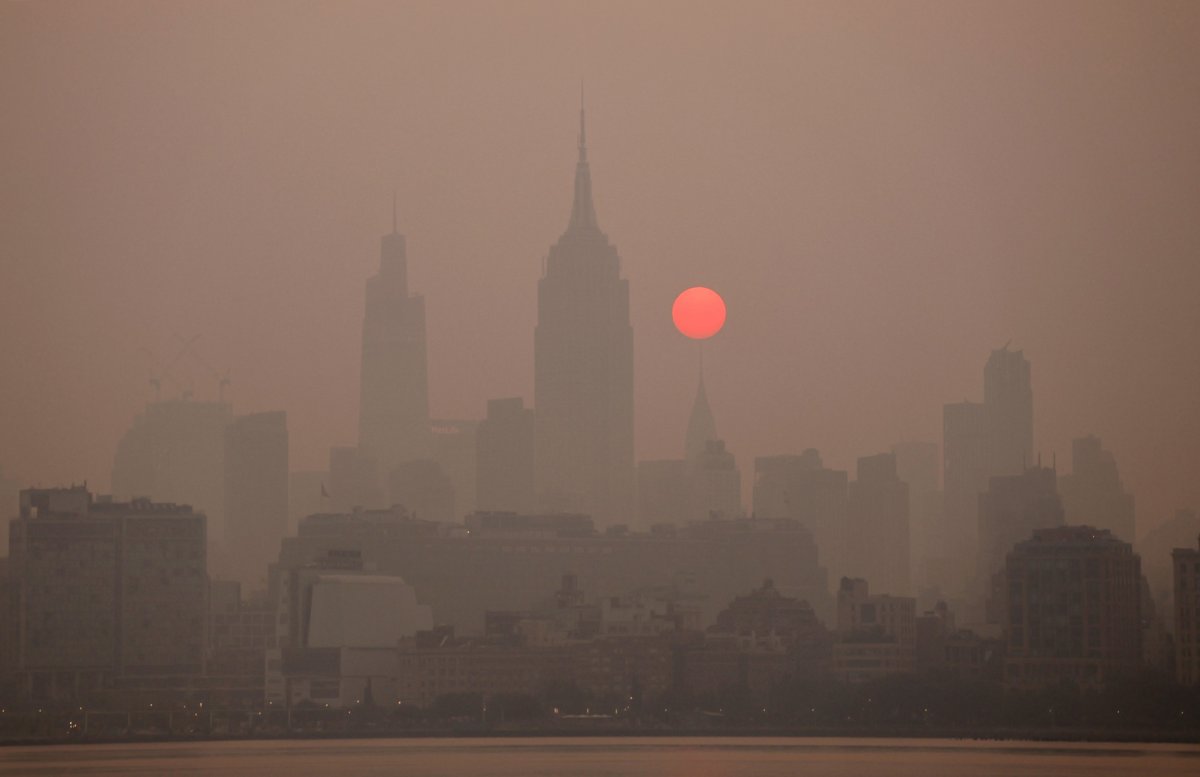As vicious wildfires continue to rage across Canada, thick plumes of smoke are billowing through swathes of the U.S., blocking out the sun and hitting air quality by choking the atmosphere.
More than 24,000 Canadians have been forced to flee their homes as hundreds of fires erupted across the province of Alberta and beyond, with horrifying videos showing the scale of the destruction over the weekend. The smoke clouds were so large and thick they could be seen from space, as demonstrated by footage shot from the International Space Station.

Experts have blamed climate change and record-breaking temperatures for the fires, which have already burned more than 6.7 million acres and forced officials to declare a state of emergency. And now Americans are feeling the effects, as the blazes wreak havoc across the border.
Capital Weather Gang, a Twitter account about the capital's weather run by the Washington Post, has been highlighting the impact on the U.S. Its graphic on air quality showed that the situation "is not normal" because it made "the Eastern U.S. look like California at the peak of fire season." The map revealed that Americans are suffering from poor air quality in disparate cities "from Minneapolis to DC to Boston."
The smoke -- making the Eastern U.S. look like California at the peak of fire season -- is not normal.
— Capital Weather Gang (@capitalweather) June 6, 2023
The air is compromised from Minneapolis to DC to Boston, and the worst from western NY to arround Ottawa. A thread... 1/ pic.twitter.com/cV8MnfdWRI
The situation has become so bad that New York City was catapulted to the very top of the list of the worst cities in the world in terms of bad air quality.
On Tuesday, June 6, NYC entered the chart and reached number seven, Canada's capital Toronto became number five, while notoriously polluted Delhi in India was deemed the worst globally. Detroit sat at number 12. By Wednesday, its rating was well over 400, putting it well past the "hazardous" range, according to the Air Quality Index (AQI) scale, which rates readings of 201-300 as "very unhealthy" and anything over 301 as "hazardous."
By 8:20 a.m. ET on Thursday, New York City sat at number one in the worst global rankings with an "unhealthy" rating of 184.
Footage shot by the New York Times and shared on Twitter showed the apocalyptic-looking skies. Drivers were issued with warnings, while flights were delayed and canceled, and a Yankees game was postponed. Photos captured by stunned residents and tourists and posted on social media showed the city's famous skyline, and landmarks such as the Statue of Liberty, shrouded in a reddish haze.
Canadian wildfire smoke darkened the skies of New York City and sent the air quality index soaring past 400 on Wednesday, well into the “hazardous” range and the worst since the EPA began recording air-quality measurements in 1999. https://t.co/kXhZndwYPH pic.twitter.com/Va9svFQgUp
— The New York Times (@nytimes) June 8, 2023
On Wednesday night, it was Philadelphia that was suffering the worst air quality compared to all the world's cities, according to local news channel CBS 3, citing AQI readings taken by AirNow. Parts of the Philadelphia region were upgraded from "code red" to "code maroon"—the most hazardous level. Skies were hazy and visibility was poor across the region as smoke blanketed the area.
CBS 3's chief meteorologist, Bill Kelly, explained that the smoke becomes thicker at night because the sun heats the air forcing the air and smoke to rise during the daytime. But as the cooler air sinks when the sun has set, the smoke also sinks back down to blanket the region.
Air quality advisories have affected up to 100 million people across the U.S. this week, according to news website Axios.
It comes as the U.S. is bracing for its own wildfire season. Some experts in California are hoping the state will see reduced risks this year due to a particularly wet rainy season. However others have warned that the rain has prompted excessive foliage growth that could create even more fuel for the fires that are likely this summer.
Health professionals have warned Americans in affected cities to stay inside if they can, avoid outdoor exercise, wear a mask while outside, and buy an air filter if they are able to do so. Asthmatics were warned to be particularly careful, and to ensure they also had their inhalers close to hand.
Until the weather pattern changes, Americans in several cities will be stuck with poor air quality and forecasters are struggling to predict when exactly the smoke will clear. Some are suggesting it could be a long-term problem.
CNN meteorologist Jennifer Gray said "this could be something we deal with off and on throughout the remainder of the summer" because Canada "is still early in their fire season."
The National Weather Service, a government agency, said on Thursday: "Wildfire smoke moving southward out of Canada and over the northern part of the country has triggered Air Quality Alerts over parts of the Great Lakes/Ohio Valley to the Northeast and Mid-Atlantic. The air quality will be decreasing over Alabama and Georgia on Thursday."
Newsweek has contacted the agency by email for further information and comment.
Uncommon Knowledge
Newsweek is committed to challenging conventional wisdom and finding connections in the search for common ground.
Newsweek is committed to challenging conventional wisdom and finding connections in the search for common ground.
About the writer
Get in touch with Chloe Mayer by emailing c.mayer@newsweek.com
To read how Newsweek uses AI as a newsroom tool, Click here.








